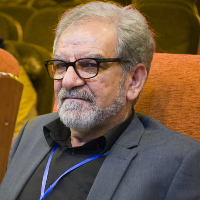Creating a graphical user interface (GUI) to automatically calculate the land surface temperature and use the results in evaluating temperature changes in land uses in Ardabil city
Background and Objective:
Land surface temperature is a vital indicator for studying environmental changes, hydrological conditions and the energy balance of the earth, which can also be used to monitor the temperature changes of cities. The lack of meteorological stations in most parts of the country, including the study area, has created information limitations in the field of surface temperature data. There are also a large number of non-remote sensing users who need LST maps, and most of them are not familiar enough with LST computing software and inevitably have to spend a lot of time mapping to prepare their maps. This process can be time-consuming even for remote sensing professionals if the number of images is high. The use of valid data for validation that has the least time difference with the satellite passes time is very important in estimating the accuracy of the results. By reviewing internal research similar to the one under study, most internal studies used only meteorological station data to validate the results, the data recording time at these stations is different from the satellite passes time. In this study, due to the large area of the study area and the insufficient number of meteorological stations, in addition to the surface temperature data measured in synoptic stations, the land surface temperature in two ground stations was recorded simultaneously with the satellite. Creating a graphical user interface (GUI) to automatically calculate the surface temperature of Ardabil city with two single-channel and RTE algorithms and use the results to evaluate the temperature changes of land uses
Materials and Methods:
In this study, in order to automatically calculate the land surface temperature of Ardabil city from three types of data: Landsat 5 and 8 satellite images, land surface temperature data recorded at two meteorological stations in the study area and also due to an insufficient number of stations Meteorological data land surface temperature data measured with digital thermometers are also used as the satellite passes. After preparing thermal and multispectral images, first MODTRAN web computing software was used to model the atmospheric transferability and atmospheric coefficients were extracted. Then, to create graphical user interfaces and automatic calculation of LST, land surface temperature with two algorithms single-channel and RTE method with Landsat 5 and Landsat 8 satellite images for two dates: 31/07/2000 and 21/08/2019 in MATLAB software were coded and using these codes, graphical user interfaces were created for each algorithm and finally, an automatic land surface temperature calculator application was produced. Also, the land use map of Ardabil city for both mentioned dates was classified and extracted using a random forest algorithm in the Google Earth engine system environment with 7 classes. This algorithm has a much better performance compared to traditional methods such as maximum likelihood due to its hierarchical structure in selecting each pixel to the appropriate class. To validate surface temperature maps from two types of surface temperature data recorded in two meteorological stations and surface temperature recorded by a digital thermometer that simultaneously passes the satellite in two points of the homogeneous non-urban environment with agricultural use (alfalfa) and Bayer that product It was harvested, used. To evaluate the accuracy of land use maps, using Google Earth, which has a better spatial resolution than the image used, 248 ground control points were obtained from pure pixels of different land uses and used in the validation process. Also, statistical parameters such as error matrix, overall accuracy and kappa coefficient were applied to the output of both land use maps.
Results and Discussion :
Using the codes written in MATLAB software, graphical user interfaces (GUI) were created and then the automatic LST calculator application was produced. The output of the application was surface temperature maps with single channel algorithms and radiation transfer equation (RTE) for 31/07/2000 using thermal image (band 6) of Landsat 5 satellite TM and 21/08 / 2019 was created by the 10 TIRS sensor band of Landsat 8 satellite. After comparing the output maps with the meteorological station and ground station data, the results showed that the single-channel method had the lowest temperature deviations compared to the stations in both years. After preparing LST maps and selecting the optimal algorithm (single channel), land use maps of Ardabil city were prepared using a random forest algorithm in the GEE platform. Statistical evaluations of the classification results showed that for 2000, the highest pixel interference was related to the middle and poor rangeland class, which has a 16-pixel displacement with residential and rainfed agricultural classes. Due to the improved spatial resolution of the Landsat 8 satellite compared to the Landsat 5, followed by better class separation, this pixel displacement in the 2019 user map shows a smaller value. The most common error was related to the aquaculture class, which had a displacement of 10 pixels with rich rangeland and rainfed agriculture classes. Finally, using the LST map and land use map, the temperature changes of the land uses over a period of 19 years were evaluated. By entering the input images and atmospheric parameters in the application, the land surface temperature was calculated with two one-channel algorithms and the RTE method. Evaluation of output maps with meteorological and terrestrial data showed that the single-channel algorithm with a difference of +2.5 and -2 with stations 1 and 2 for the year 2000 and with a temperature difference of +1.3, +0.9, -1 and -0.9 with stations 1, 2, 3 and 4 in 2019, respectively, had higher accuracy than the RTE method. Also, the results of validation of land use maps showed an overall accuracy of 0.95 and a kappa coefficient of 0.94 for 2000 and overall accuracy of 0.96 and a kappa coefficient of 0.95 for 2019.
Conclusion :
Assessing the relationship between land surface temperature and land use maps showed that despite the significant physical growth of the urban sector over a period of 19 years, except for residential areas, all land uses in 2019 compared to 2000 with an increase in average surface temperature. It seems that factors such as the expansion of agricultural lands with irrigated cultivation around the urban area up to a radius of 10 km and the entanglement of these farms with the urban sector have a great impact on the temperature adjustment of the urban sector. In 2000, these lands were mainly under cultivation of rain-fed crops, and by solving the water problem (digging deep wells and water transfer projects), they became orchards and irrigated farms such as potatoes. Due to the high water requirement, these products also have high greenery, and this factor has increased the rate of evapotranspiration, followed by cooling of the cultivation area and the urban sector. Among other classes, in both years of water use, the lowest and the use of barren lands had the highest average surface temperature. The generated application can be run on any operating system that supports the exe format, and the user by specifying atmospheric parameters can automatically estimate the LST. This application can also be used in various sectors such as agricultural systems, and climate and water resources management.
- حق عضویت دریافتی صرف حمایت از نشریات عضو و نگهداری، تکمیل و توسعه مگیران میشود.
- پرداخت حق اشتراک و دانلود مقالات اجازه بازنشر آن در سایر رسانههای چاپی و دیجیتال را به کاربر نمیدهد.




